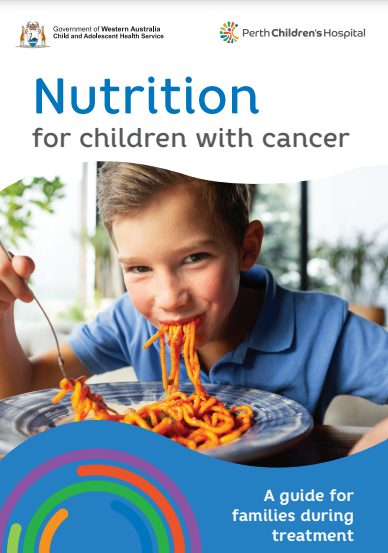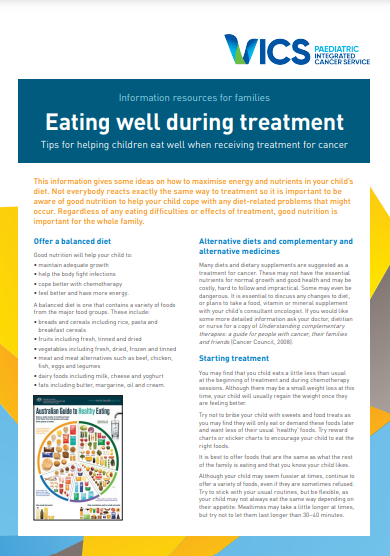Shining the spotlight on nutrition and dietetics in paediatric oncology
Thursday 5 September
During Childhood Cancer Awareness Month, we’re sharing the A to Z of ANZCHOG on our LinkedIn and Twitter (X). The A to Z highlights a comprehensive look at some of the work we do both in clinical trials and as the peak body for paediatric haematology and oncology in Australia and New Zealand.
Today’s letter is D and we are shining the spotlight on dietetics and nutrition during childhood cancer treatment. To help us learn more about this important field, and to share some tips for families and healthcare practitioners, we spoke to Dr Amy Lovell, a Senior Lecturer at the University of Auckland, Nutrition and Dietetics Department who also works clinically at the Cancer Centre in Auckland. Read Amy’s fascinating insights and advice below, and access some helpful nutrition resources at the end of this article.
Whilst Amy was completing her PhD, she worked part-time as a paediatric dietitian at the Starship Children’s Hospital in Auckland, New Zealand where she was first introduced to the oncology ward. After that, she never looked back, saying “I could see how much nutrition was impacted throughout treatment for patients and their families but was also frustrated by how quickly nutrition could be sidelined within the context of treatment. I knew that if we wanted to change clinical practice we would need to back it up with research and also identify the things that are important to our patients and families. So, in 2021 I began my research career in paediatric oncology!”
Around 40 percent of Amy’s role at the University of Auckland is dedicated to research, where she uses her experiences with patients and families to inform research projects and applications for funding. Central to her research projects is the patient and family experience, where she identifies the gaps in nutrition interventions and support and co-designs solutions with those who have gone through or are currently going through treatment.
When talking about the importance of dietetics and nutrition, Amy says …
“There have been so many great advances in treatment protocols and we are so lucky that our survival rates now exceed 85%; however this success is associated with many children experiencing short- and long-term nutrition-related adverse effects. We know that poor nutritional status is an independent risk factor for event-free survival, malnutrition (both underweight and overweight/obesity) is associated with treatment toxicities, and nutrition is a modifiable risk factor for chronic disease in survivorship. Therefore, maintaining good nutrition status during treatment is paramount. This means that patients need early and sustained nutrition [and activity] supports through treatment.
Providing nutrition supports and interventions to patients with cancer isn’t just about weight loss. Many of our children experience high weight throughout treatment and reducing the impacts of this during and after treatment is of growing research interest. Strategies are much more nuanced than “any calorie is a good calorie”, and our patients need supports with maintaining good diet quality (i.e. continuing to eat fruits and vegetables), ensuring micronutrient dense food options, optimising dietary fibre intake, and responsive feeding practices that ensure that our children continue to grow and develop during this challenging time.”
Amy shares some of the nutritional challenges faced by children and adolescents and some advice for families to manage these, saying …
“We know that there are certain diagnoses that carry more of a malnutrition (undernutrition) risk than others, e.g. neuroblastoma or high-risk leukaemia, and other diagnoses place children and young people at risk of overweight/obesity e.g. standard and medium risk ALL. Some parts of therapy, like the use of corticosteroids influence feeding and eating behaviours and compromise bone mineral density, and there are definitely chemotherapy agents that are more emetogenic than others, significantly impacting intake and quality of life. We know that the biggest changes in physical activity, loss of lean muscle mass, increases in fat mass, and changes to dietary intake occur early (i.e. within the first 6 weeks of treatment) and that this might be the window in which we need to act to prevent long term consequences of poor nutritional status. But we need more research first!
Generally, my advice to families is (once we have a good antiemetic regimen in place!) to continue to make sure that we are offering nutritious meal and snack options at each eating occasion. This means that we are choosing food options that are a protein source + carbohydrate source + fruit/vegetable. This means that if we have one eating occasion that is impacted by side effects/low appetite, we know that the next eating occasion will also provide those key nutrients. For diagnoses where we know the probability of needing nutrition supports (oral or enteral) is high, I have these conversations early and gently, to avoid enteral nutrition being used as a punishment for weight loss or poor intake. Most importantly, I encourage families to maintain positive feeding and eating behaviours (both parents and patients) to ensure that we don’t set up feeding practices that may be detrimental to intake in survivorship (think, The Division of Responsibility and Responsive Feeding). I really try and avoid setting a maximum weight loss before enteral nutrition is considered, as these conversations don’t come from a position of strength for our patients. Finally, my goal is to try and keep nutrition and food choices ‘as normal as possible’, so that when we are transitioning into survivorship, dietary intakes are aligned with recommendations and challenges like food aversions or selective eating are minimised.”
Finally, Amy shares her strategies for families managing treatment side-effects of nausea, vomiting and/or lack of appetite …
“My first strategy is to make sure that the anti emetic regimen is optimised for patients and that there is a plan for escalating anti emetics during intensive treatment cycles. Without this it’s very difficult for patients to eat and drink! Small, frequent meals are always a first option for managing nausea and low appetite and making every mouthful count with balanced meals and snacks (protein + carb + fruit/veg) is a good place to start. Sometimes taking the focus away from eating and looking at other ways we can enjoy food can be useful too if we are feeling up to it.”
Nutrition resources available for families (click images to access)



